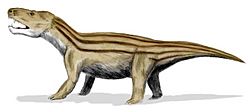Cynognathus facts for kids
Quick facts for kids CynognathusTemporal range: Triassic
|
|
|---|---|
 |
|
| Cynognathus | |
| Scientific classification | |
| Kingdom: | |
| Phylum: | |
| Class: | |
| Order: | |
| Suborder: | |
| Family: |
Cynognathidae
|
| Genus: |
Cynognathus
|
| Binomial name | |
| Cynognathus crateronotus |
|
Cynognathus was an amazing creature from long ago. It was a type of cynodont, which means it was a mammal-like reptile. Imagine an animal about the size of a wolf, but living millions of years ago!
This ancient animal was not a dinosaur. It was a therapsid, a group of animals that came before mammals. Cynognathus lived during the early to middle Triassic period. This was roughly 230 to 245 million years ago.
Scientists believe Cynognathus was warm-blooded, like mammals today. It might have even given birth to live young, instead of laying eggs. Fossils of Cynognathus have been found in South Africa and Argentina. This shows it lived across a supercontinent called Pangaea.
Contents
What Was Cynognathus?
Cynognathus means "dog jaw." This name comes from its strong, dog-like teeth. These teeth were perfect for eating meat. It was a fierce predator of its time.
Cynognathus belonged to a group called cynodonts. Cynodonts were very important in Earth's history. They are seen as a link between reptiles and mammals. They had many features that we see in mammals today.
Life in the Triassic Period
The Triassic period was a time of big changes on Earth. All the continents were joined together in one huge landmass called Pangaea. This supercontinent had vast open plains.
Cynognathus lived in these open plains. The climate was likely warm and dry. This environment was home to many different kinds of animals. Cynognathus was one of the top predators.
Where Did Cynognathus Live?
Fossils of Cynognathus have been found in several places. These include South Africa and Argentina. This wide distribution is special. It tells us about the ancient supercontinent of Pangaea.
Finding fossils on different continents helps scientists. It shows how landmasses were connected long ago. It also helps us understand how animals spread across the Earth.
How Do We Know About Cynognathus?
Scientists learn about Cynognathus from its fossils. The first fossils were found in South Africa. These discoveries helped us understand what this animal looked like. They also showed how it lived.
One important fossil is the skull. The skull of Cynognathus shows its powerful jaws. It also reveals its sharp teeth. These features tell us it was a carnivore, meaning it ate meat.
Images for kids
See also
 In Spanish: Cynognathus para niños
In Spanish: Cynognathus para niños



